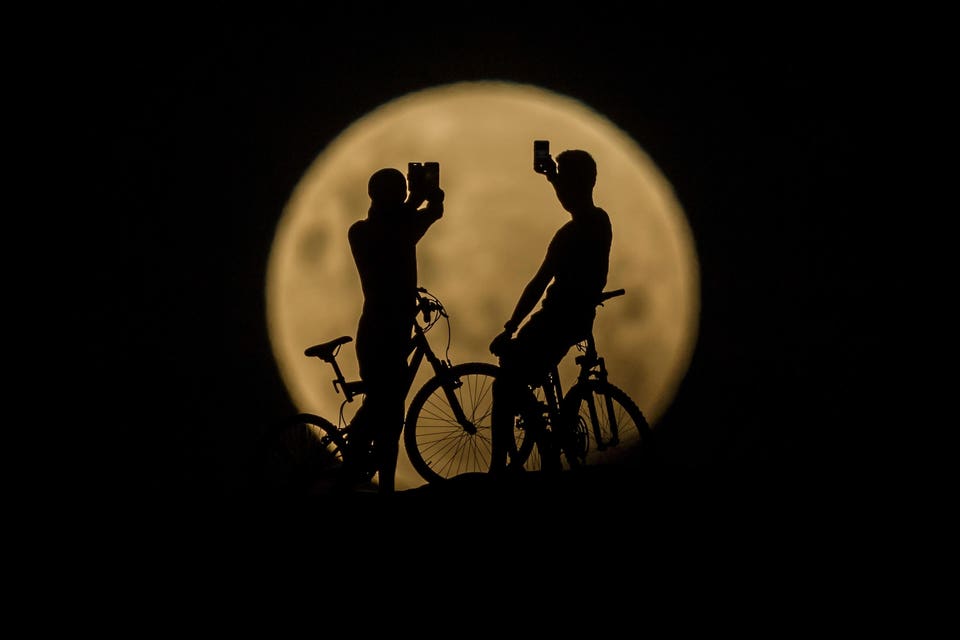Forbes Innovation Science ‘Buck Supermoon’ And Venus At Brilliant Best: The Night Sky This Week Jamie Carter Senior Contributor Opinions expressed by Forbes Contributors are their own. I inspire people to go stargazing, watch the Moon, enjoy the night sky Following Jul 2, 2023, 07:15pm EDT | Press play to listen to this article! Got it! Share to Facebook Share to Twitter Share to Linkedin This week sees the rise of 2023’s first “supermoon. ” Here’s one from January 31, 2018 in Lancelin, .
. . [+] Australia.
Getty Images Each Monday I pick out the northern hemisphere’s celestial highlights (mid-northern latitudes) for the week ahead, but be sure to check my main feed for more in-depth articles on stargazing, astronomy, eclipses and more. The Night Sky This Week: July 3-9, 2023 This week sees the rise of 2023’s first “supermoon. ” Although it’s a term that has its roots in astrology, the specter of a slightly larger (and, more noticeably, brighter) full moon gets a lot of people going out to see a fabulous moonrise.
That makes supermoons alright by me. The “Buck Supermoon” is actually the first of four supermoons this year the other being on August 2, August 31 and September 29, 2023. The full moon may dominate the eastern night sky this week but don’t forget to watch Venus at its brilliant best on the opposite side of the post-sunset sky.
Monday, July 3: Full ‘Buck Supermoon’ The first full Moon of summer in the northern hemisphere, the “Buck Moon” will also be the first of four supermoons in 2023, albeit the farthest from Earth at 361,934 km. Best viewed at moonrise on Sunday, July 2, 2023, just before it turns 100% full. A composite of images of the an annular eclipse in 2012 as seen from the Grand Canyon, the first .
. . [+] seen from the U.
S. since 1994. Getty Images MORE FOR YOU Welcome To Halla, The Planet That Cheated Death The Apocalypse Barely Missed Us 115 Years Ago But It Could Happen Any Moment Webb Telescope Drops Astonishing New Images Of Saturn In Infrared Thursday, July 6: Earth Farthest From The Sun And A Countdown To A ‘Ring Of Fire’ Eclipse Today is Earth’s aphelion when our planet is as far from the sun as it ever gets on its slightly elliptical annual orbit.
It’s also now 100 days until an annular solar eclipse—known as a “ring of fire”—in North America. The October 14, 2023 event will peak with 90%of the center of the sun covered by the moon as seen from a 100 miles-wide path from Oregon to Texas and on to Mexico, Central America and South America. Saturday, July 7 (Just After Midnight): Moon And Saturn Stellarium Saturday, July 7 (Just After Midnight): Moon And Saturn Rising in the eastern night sky just after midnight in the early hours of July 7 will be an 80%-lit waxing gibbous moon and, about 3º above it, the ringed planet Saturn.
Saturday, July 7 (After Sunset): Mars, Venus And Regulus Stellarium Saturday, July 7 (After Sunset): Mars, Venus And Regulus In the west after dark will be the lovely sight of a very bright Venus below both ruddy Mars and bright star Regulus, the brightest star in the constellation Leo and around 79 light-years from the solar system. Sunday, July 9: Venus Brightest In 2023 As seen from Earth, the position of Venus will change dramatically this summer. On July 9 it will be at its brilliant best as the bright “Evening Star” close to the horizon just before starting its retreat.
It will soon dip into the Sun’s glare to re-emerge as a brilliant “Morning Star” in the pre-dawn skies, peaking in brightness on September 18. The first full-disc picture of Venus taken by the Pioneer Venus Orbiter in the 1970s. Bettmann Archive Object Of The Week: Venus As an inner planet, Venus appears to us on Earth to have phases.
At the moment it’s waning as it begins to dip into the sun’s glare. Put a small telescope on the bright cloudy planet and you’ll see it as a 25%-lit crescent. Sadly that crescent isn’t visible to the naked eye or through binoculars.
Times and dates given apply to mid-northern latitudes. For the most accurate location-specific information consult online planetariums like Stellarium and The Sky Live . Check planet-rise/planet-set , sunrise/sunset and moonrise/moonset times for where you are.
Wishing you clear skies and wide eyes. Follow me on Twitter or LinkedIn . Check out my website or some of my other work here .
Jamie Carter Editorial Standards Print Reprints & Permissions.
From: forbes
URL: https://www.forbes.com/sites/jamiecartereurope/2023/07/02/buck-supermoon-and-venus-at-brilliant-best-the-night-sky-this-week/



